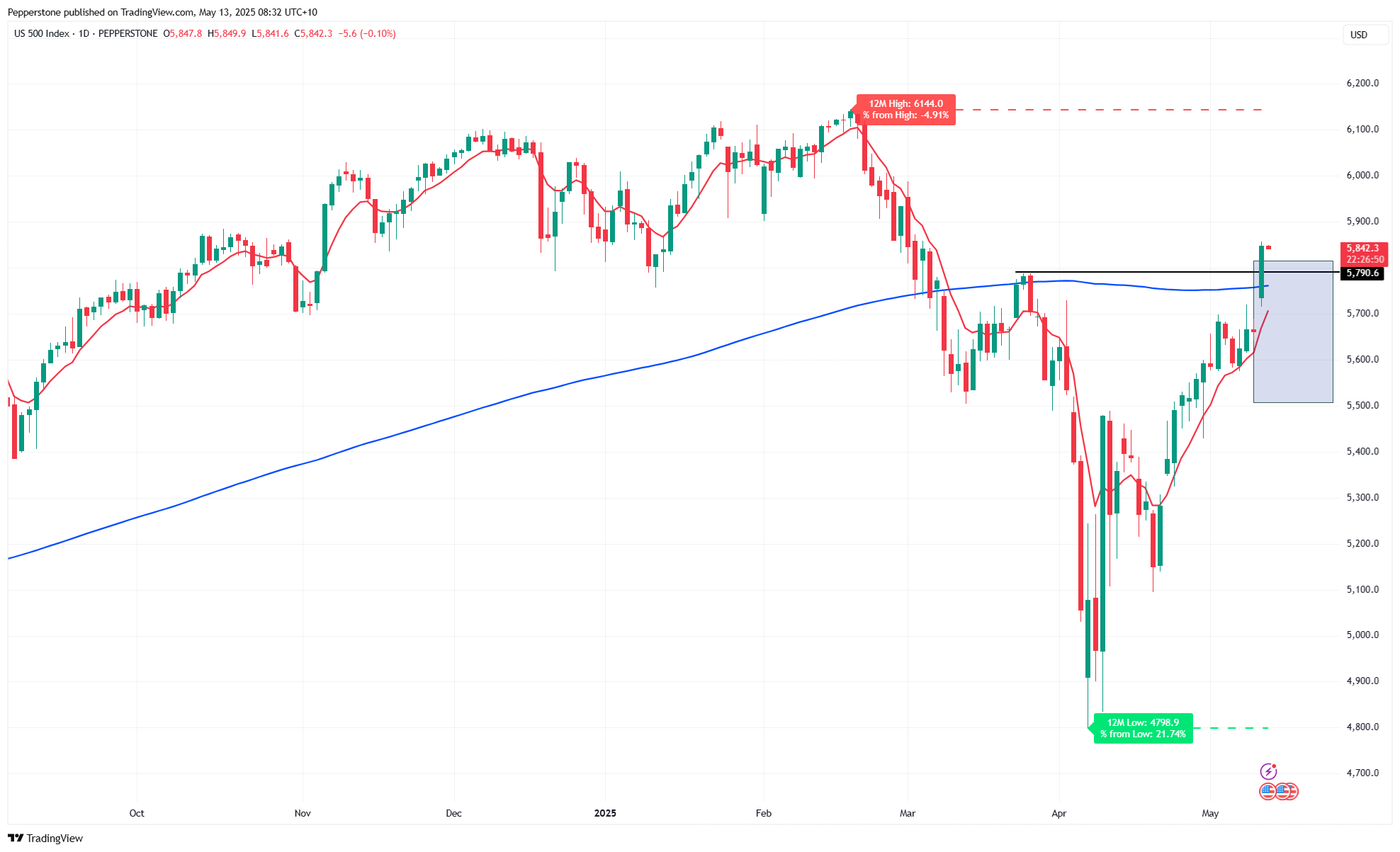Analysis
The S&P500 and NAS100 Rally Hard: Tariff Cuts and Recession Risks Recede

By taking down the tariff rate on Chinese goods to 30% - 10% on the reciprocal base line tariff and 20% fentanyl - the US will now have an effective rate of 13% (from 23%), with US exporters set to be impacted by a far more palatable 10% tariff rate. These levels represent a clear statement of intent and essentially fall in line with the levels most had anticipated tariffs would be pre-Liberation Day.
While we still await a US trade pact with the EU, the prospect of tough talk from the Trump camp into high-level meetings that ultimately result in lower tariffs with EU nations now seems realistic.
US corporations refrained from offering guidance through this earnings season, but the question many will now pose in the boardrooms centres on whether these actions offer them the certainty to start making investment decisions when the visibility just wasn’t there before.
Clearly, those in the C-suite and executive teams will be enthused at the direction trade talks are going, but the overhang of an impending reassessment in 90 days remains a key sticking point, and businesses will need to consider the probability that Trump and Bessent revert to the prior extreme tariff rates. One suspect they’ll see that probability as a low risk, as a genuine ‘reset’ suggests the new levels will indeed hold and potentially even come down – at the least, these actions will go some way in mitigating the risk of increased layoffs in the months ahead, and we watch the soft data sentiment surveys more intently to see if there is any noticeable bounce in US corporate outlooks.
On the day we see that the implied US recession risk (in the coming 12 months) in the betting markets has dropped 11 ppt to 39%. The reaction in markets is where the focus really sits, and the reaction has been clear-cut - with US equity and the USD running hot, while the classic recession hedges have been cut up.
The market reaction to the US-China tariff reduction
In the volatility space, we see implied US equity implied volatility fully normalising – the cash VIX trades 3.5 vols lower at 18.4%, falling in line with the 12-month average. The VIX front-month future now trades at a 1.9 volatility (vol) discount to the VIX 6th month future, with S&P500 skew (S&P500 25-delta 1-month put implied vol – S&P500 25-delta 1-month call vol call vol) pulled back to a 4.9 vol premium and in line with what is typical in calmer market environment.
Outside of the volatility space, we see a solid unwind of CHF and JPY longs, gold -2.9 % and US 2yr Treasury yields +12bp, which has resulted in a 2.5bp bear flattening of the 2s v 10s yield curve. We’ve also seen a solid repricing of Fed rate cut expectations, with SOFR futures seeing the implied trough/terminal Fed rate +17bp and now sits at 3.44% for September 2026.
It’s also worth noting that US inflation expectations have been smacked hard, with US 1-year and 2-year inflation swaps -26bp and 16bp, respectively.
US equity has flown with the buying centred in the SPX consumer discretionary and tech sectors, with the MAG7 basket +5.7%. Tech is back in vogue and found its mojo, where past calls for the death of US exceptionalism looking redundant – we can caveat that call through the idea that while there are renewed attractions in US assets and towards those businesses with strong earnings growth, high ROE and solid pricing power, investors have been awaken to the fact that they have a far greater choice from a geographical perspective than perhaps was the case pre-2025. Strong momentum and trend suggest the risk for US equity is for higher levels

Strong momentum and trend suggest the risk for US equity is for higher levels
S&P500 futures have smashed through the 200-day MA and the 25 March high and now need to find another 4.9% for the ATH set on 19 Feb – I don’t think we can rule that out, and on the current trend, we could be there by next week. Subsequently, I remain biased for higher levels in both the SPX and NAS100 but would look to square that view on a daily close below the 8-day EMA.
The reaction to higher UST yields, the repricing of implied Fed rate cut expectations through the US rates/swaps markets, and the renewed confidence to hold US risk has resulted in a solid 1.5% rally in the USD index (DXY). The notable flows have been seen vs the JPY, CHF and EUR, which have all recently benefited from the capital flight/repatriation flows, which resulted in an overly crowded position.
US core CPI will be a risk to those set in USD and US equity positions in the session ahead, but unless we see a dramatically weaker-than-expected inflation outcome, I would look to buy any weakness in the USD that comes as a result of the CPI outcome, as the prospect of a further squeeze higher seems elevated.
Asia equity to fire up - Our ASX200 opening call is now just 3.2% from the all-time high
Naturally, Asia equity should fire up on open, where our calls suggest the ASX200 opens +1.3% at 8340 and the NKY225 +2.9%. The HK50 looks set to underperform the region, but this comes off the back of a 2.9% rally seen in the prior session, with HK tech having a solid run. Onwards and upwards, and we look up at the ATHs in the ASX200, which from our opening call is a mere 3.2% away.
Good luck to all.
The material provided here has not been prepared in accordance with legal requirements designed to promote the independence of investment research and as such is considered to be a marketing communication. Whilst it is not subject to any prohibition on dealing ahead of the dissemination of investment research we will not seek to take any advantage before providing it to our clients.
Pepperstone doesn’t represent that the material provided here is accurate, current or complete, and therefore shouldn’t be relied upon as such. The information, whether from a third party or not, isn’t to be considered as a recommendation; or an offer to buy or sell; or the solicitation of an offer to buy or sell any security, financial product or instrument; or to participate in any particular trading strategy. It does not take into account readers’ financial situation or investment objectives. We advise any readers of this content to seek their own advice. Without the approval of Pepperstone, reproduction or redistribution of this information isn’t permitted.